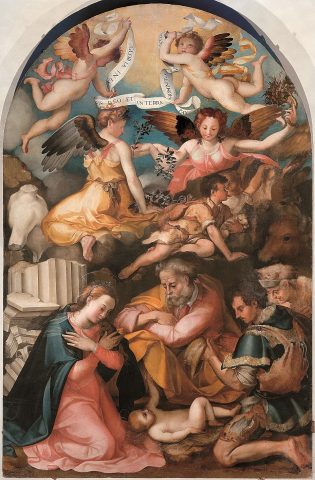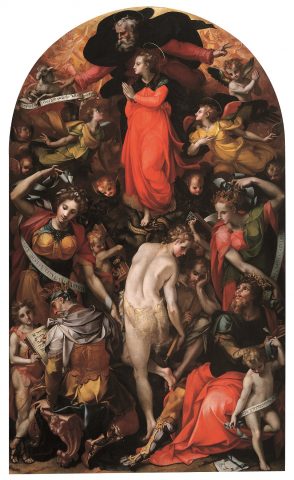Carlo Portelli: a seminal exhibition retraces his mastership
- Carlo Portelli, Portrait of a young man, 1543-1545 circa. Fontaine-Chaalis, Institut de France, Abbaye Royale de Chaalis.
- Carlo Portelli, Duke Alessandro de’ Medici (from Giorgio Vasari), 1555-1565. Venice, Antichità Pietro Scarpa
- olio su tavola, 125,5×97 cm, dono di Harold Godwin, inv. y340
- Carlo Portelli, Allegory of the Charity, 1550-1560. Madrid, Museo Nacional del Prado.
- Carlo Portelli, Charity, 1555-1560. Maastricht, Bonnefantenmuseum. Loan from the Cultural Heritage Agency of the Netherlands.
- Carlo Portelli, Holy Mary with Child, Saint Lawrence e Saint Cecilia, 1540-1545. San Casciano in Val di Pesa (Firenze), pieve di Santa Cecilia a Decimo.
- Carlo Portelli Crucifixion, 1542-1545 circa. Museo del Cenacolo di Andrea del Sarto.
- Carlo Portelli, Trinity, 1545 circa. Tavola Firenze, chiesa di Santa Felicita.
- Carlo Portelli, Nativity, 1555 circa. Florence, chiesa di San Michele a San Salvi.
- Carlo Portelli, Allegory of the Immaculate Conception, 1566. Firenze, Galleria dell’Accademia.
The first comprehensive retrospective exhibition dedicated to Renaissance artist Carlo Portelli opened a few days before Christmas in Florence, at the Accademia Gallery, and will run until the end of April (Carlo Portelli: Pittore eccentrico tra Rosso Fiorentino e Vasari). As art historian Lia Brunori, the exhibition’s curator along with her colleague Alessandro Cecchi, told to Cfa during a very exclusive preview that she granted us while workers were still hanging paintings on the walls (under the strict surveillance of their couriers), ‘this is the very first time in history that all the works known by Portelli share the room’. And since Portelli is not a celebrated master such as Ridolfo del Ghirlandaio, Brozino or Andrea del Sarto, this event represents a sort of late re-birth for him and his mastership.
As Ms. Brunori stated, the show stems from Portelli’s highly appreciated Allegory of the Immaculate conception (1566), a glorious altar piece that is permanently on exhibition at the Accademia Gallery, in the same room where also Michelangelo’s David is located. This extremely sensual painting, focused on the female yet eerily masculine nude figure who offers her back side to the viewer while staring at him with enigmatic eyes, is largely considered the artist’s masterpiece. ‘It is dated and signed – adds Ms. Brunori –, as just a few other works by Portelli are, and that is also why it is so important’.
Until this show, very little was known about the early years of the artists career, except that he probably studied with Ridolfo del Ghirlandaio (Vasari, Le Vite) and that in 1539 he executed a painting after an original drawing by Francesco Salviati made in occasion of the wedding between Duke Cosimo I de’ Medici and Eleonora of Toledo. Nothing more is certain in Portelli’s biography during the period that goes from the artist’s birth, perhaps occurred at the dawn of XVI century in Loro Ciuffenna, to the altar piece he executed in 1555 for his home-town’s main church, Santa Maria dell’Assunta. During this years, which represent the golden age for Tuscany Renaissance art, Portelli is strongly influenced by artists more talented than him such as, for instance, Andrea del Sarto and Fra Bartolomeo, whose style can easily be spotted in Portelli’s paintings along with references to Bronzino, or Salviati. ‘But it wouldn’t be correct to affirm that he just copied these models – Ms. Brunori explains. Portelli was more that kind of artist who took inspiration, made crossovers, or re-enacted elements to produce something original and quite autonomous’.
Thanks to the research conducted by Alessandro Checchi, some new documents regarding Portelli’s life have been discovered. Among them, for instance, there is the original paper which proves his registration to the Florentine Accademia delle Arti e del Disegno (dated 1538). Today something more is known also about his family, studio, and were he lived. All these small but important discoveries and documents are gathered together in the exhibition’s opening room, along with some early works like the delicate Allegory of the Fortune from a private collection, here presented to the public for the first time ever.
As noted by Carlo Falciani in his contribution to the exhibition’s catalogue, most of the portraits currently attributed to Portelli, and carefully selected by the curators for this occasion, are not signed or dated. Art historian assigned them to the artist just on the basis of their style, especially with regards to faces and hands, which are in fact not so clear evidences. Falciani, who is an expert in Florentine portraits of this period and curated one of the best shows of last year, meaningfully also writes about the artist’s decline, which began during the last quarter of the XVI century. At the time when a new generation of artists were emerging around the so called “Studiolo” of Francesco I de’ Medici Portelli seemed unable to cope with the new naturalistic approach adopted by brilliant painters such as Alessandro Allori or Santi di Tito. According to Vincenzo Borghini, a pitiless coeval observer quoted by Falciani, in 1571 Portelli was already considered old and out of fashion. Whether this current pivotal step in the artist’s post mortem career will represent his come back 445 years later or not it’s hard to predict. But we would bet that Cecilie Hollberg, who has been named director of the Accademia Gallery just a few months ago and is still getting accustomed to her new task, certainly hopes so. This would be the perfect prelude to her new directorship.
November 25, 2020










